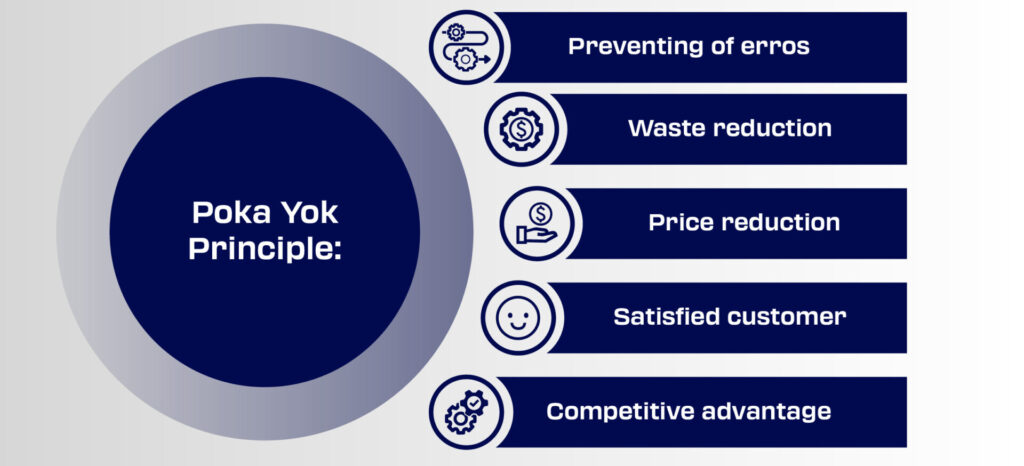In your operation, errors don’t knock on the door. They show up in rework reports. In lost batches. In customer complaints. Or worse — in your financial results.
Incorrect assembly, the wrong part, a missed sensor. These are simple failures that silently drain profits every day — and you know it. But what perhaps hasn’t been clearly said is: you can eliminate these errors before they happen.
That’s exactly where Poka Yoke comes in — the line of defense your process should never go without.
In this article, you’ll learn:
- What Poka Yoke is and where it came from;
- Real-world examples in industrial environments;
- How to implement it to reduce failures and costs — and boost efficiency with simple, effective solutions.
If the same errors keep coming up in your quality meetings, this content is for you.
What is Poka Yoke?
Created by Shigeo Shingo, one of the minds behind Toyota, Poka Yoke is more than a Japanese philosophy. It’s a practical strategy to eliminate operational failures.
The idea is simple yet powerful: implement physical, visual, or logical mechanisms that either prevent errors from happening or make them immediately detectable and correctable.
Unlike other approaches that deal with errors after they occur (like inspections or audits), Poka Yoke acts at the source, within the process itself. It’s part of the quality at the source philosophy — quality must be built into the operation, not just verified at the end.
In industrial practice, that means creating systems that:
- Prevent incorrect part orientation or assembly;
- Block the process if a previous step hasn’t been completed;
- Alert the operator if wrong data is entered into the system;
- Automatically detect missing components, labels, or materials.
Often, these are simple solutions — a sensor, a physical lock, an indicator light, or a digital validation. But their impact is powerful: fewer failures, less rework, less waste.
According to Six Sigma, a successful Poka Yoke implementation can improve customer satisfaction by up to 20%.

The 4 Types of Poka Yoke Your Factory Needs
In industrial routines, small slips can lead to big losses. But Poka Yoke acts like a silent guardian of quality. And understanding its types is the first step toward turning human error into consistent results.
According to Six Sigma, Poka Yoke mechanisms are divided into four main categories:
Control Type: The process doesn’t move forward unless it’s correct
This is the most robust form. It automatically stops the process when an anomaly is detected. Nothing continues until the issue is fixed.
Examples:
- Assembly line halts if a part is missing;
- System blocks progress if steps are out of sequence.
This type removes the need for human attention — it makes it impossible to proceed with a faulty process.
Warning Type: Error is detected, but correction is up to the operator
This acts as an alert — signaling something is wrong but leaving the fix to the human operator. It’s a low-cost option ideal for steps that can’t be fully automated.
Common uses:
- Warning light for low hydraulic oil levels;
- Alarm for misplaced lids or sensors.
It doesn’t stop the process, but it drastically reduces the chances of errors going unnoticed.
Input Verification: Preventing errors before the process even begins
This acts like an intelligent filter — validating that materials or data are correct before they’re used.
Industrial uses:
- Auto-validation of product codes in ERP or MES systems;
- Format and value checks for data fields like batch numbers or temperatures.
Perfect for logistics, quality control, industrial IT, and traceability processes.
Successive Verification: Audit each step before moving on
This type focuses on safe sequencing. Each step is validated before the next begins, preventing errors from carrying over.
Examples:
- Welding inspection before final assembly;
- Batch records reviewed before shipping approval.
This ensures quality stays close to the root cause — not just damage control at the end of the line.

Read also: What is Lead Time? How to Reduce and Optimize Your Production
Common Industrial Errors Poka Yoke Can Prevent
Often, what hurts productivity, quality, and reliability the most are the small, repetitive, silent mistakes. Poka Yoke was designed to eliminate these — systematically and intelligently.
According to QAD Redzone, three common industrial errors can be significantly reduced:
Setup Errors
Even before production starts, setup mistakes can ruin a whole batch — incorrect torque, misaligned tools, or outdated parameters.
How Poka Yoke helps:
- Sensors confirm correct setup;
- Calibrated displays block operation outside safe range;
- Digital validations check against expected parameters;
- Shift-specific checklists avoid reliance on memory;
- Visual cues like QR codes ensure machine is set for the correct SKU.
Result: More stability, less operator dependency.
Missing or Incorrect Parts
Installing the wrong component can be catastrophic — especially with multiple variants. If not caught, it can reach the end customer.
How Poka Yoke solves this:
- Pick-to-light systems highlight the correct part;
- Color-coded boxes expose wrong picks;
- Component counters block progress when parts are missing;
- Smart nests ensure all parts are in place;
- Object recognition cameras check orientation and placement.
Result: Up to 35% fewer assembly errors.
Measurement and Execution Errors
Even skilled operators can slip — misreading instruments, skipping steps, or entering wrong numbers.
How Poka Yoke acts:
- Real-time digital checklists ensure all measurements are done;
- Tablet or panel alerts require double-checking;
- Integrated digital calipers eliminate manual data entry;
- Laser verifications confirm alignment.
Result: Less guesswork, more traceability and confidence.

Read also: What is VSM and Why It Revolutionizes Your Production
How to Implement Poka Yoke in Your Factory: From Observation to Operational Excellence
In theory, Poka Yoke is simple: prevent the error. But in practice, it requires deep attention to detail — the kind usually overlooked in the rush of the shop floor.
Effective implementation goes beyond installing sensors. It requires listening, frontline collaboration, and continuous improvement.
Here’s a proven step-by-step, used by companies like Companion Baking, which increased OEE by 30% in 60 days using Redzone:
Field diagnosis
Observe the line. Talk to operators. Use tools like Redzone to spot patterns invisible in reports.
Root cause analysis
Apply the “5 Whys.” A torque error might be due to an outdated sheet, not operator fault.
Choose the right Poka Yoke method
Not everything needs AI. Sometimes, a simple fixture solves it. But where it matters, use smart tech.
Test, standardize, scale
Start in a well-measured area. Implement, analyze, and scale only what works.
Training and documentation
For Poka Yoke to work long-term, your team must understand why the change matters — not just the “how”.
There Is a Way to Scale Quality and Cut Costs at the Same Time
You need a system that won’t let errors slip through.
Redzone helps you bring Poka Yoke to life:
- Identify where errors originate;
- Standardize work without bureaucracy;
- Engage operators with real-time data and feedback.
Companies have reported a 14-point increase in OEE in just 90 days using this approach.
Talk to our team and discover how applying Poka Yoke with Redzone could save millions for your operation.










